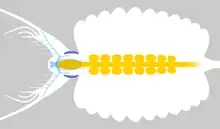Kerygmachela
Kerygmachela kierkegaardi is a gilled lobopodian from the Cambrian Stage 3 aged Sirius Passet Lagerstätte in northern Greenland. Its anatomy strongly suggests that it, along with its relative Pambdelurion whittingtoni, was a close relative of radiodont (anomalocaridids) and euarthropods.[2][1] The generic name "Kerygmachela" derives from the Greek words Kerygma (proclamation) and Chela (claw), in reference to the flamboyant frontal appendages. The specific name, "kierkegaardi" honors Danish philosopher Søren Kierkegaard.[2][1]
| Kerygmachela Temporal range: | |
|---|---|
 | |
| Fossil of Kerygmachela kierkegaardi from the Sirius passet site | |
 | |
| Reconstruction of Kerygmachela kierkegaardi based on later observation of 2018.[1] | |
| Scientific classification | |
| Domain: | Eukaryota |
| Kingdom: | Animalia |
| Phylum: | Arthropoda |
| Class: | †Dinocaridida |
| Genus: | †Kerygmachela Budd, 1993 |
| Species: | †K. kierkegaardi |
| Binomial name | |
| †Kerygmachela kierkegaardi Budd, 1993 | |
Morphology

The head of Kerygmachela possesses a pair of well-developed frontal appendages which correspond to those of other dinocaridids and siberiid lobopodians.[3] Each of them terminates in a series of long spines. A pair of sessile, slit-like compound eyes is located slightly behind the base of these appendages.[1] A small anterior-facing mouth is located below the head and bears a pair of stylet-like structures.[1] The head also possesses a median lobe-like projection that carries a pair of small, possible ocular structures.[1] The body is composed of 11 segments, each indicated by 4 dorsal turberculates associated with 11 pairs of lateral flaps with dorsal gill-like structures,[2] along with 11 pairs of small legs (lobopods) located just below the flaps.[2] The body ends with a single tail spine[1] that was formerly thought to be a pair of cerci.[2][4]
Internally, Kerygmachela possesses a well-developed pharynx[1] and a midgut with 8 pairs of arthropod-like digestive glands.[5] The brain is composed of only protocerebrum (the frontal-most cerebral ganglion) with ramified nerves extended to the median lobe, frontal appendages and eyes.[1]
Paleoecology
The spiny frontal appendages suggests that Kerygmachela may have been a predator; however, fossils indicate a total size of approximately 175 mm and, with a relatively small mouth, suggest that it would have been restricted to very small prey.
| Part of a series on |
| The Cambrian explosion |
|---|
 |
References
- Park, Tae-Yoon S.; Kihm, Ji-Hoon; Woo, Jusun; Park, Changkun; Lee, Won Young; Smith, M. Paul; Harper, David A. T.; Young, Fletcher; Nielsen, Arne T.; Vinther, Jakob (2018-03-09). "Brain and eyes of Kerygmachela reveal protocerebral ancestry of the panarthropod head". Nature Communications. 9 (1): 1019. doi:10.1038/s41467-018-03464-w. ISSN 2041-1723. PMC 5844904. PMID 29523785.
- Budd, Graham E. (1993), "A Cambrian gilled lobopod from Greenland", Nature, 364 (6439): 709–711, doi:10.1038/364709a0, S2CID 4341971
- Ortega‐Hernández, Javier (2016). "Making sense of 'lower' and 'upper' stem-group Euarthropoda, with comments on the strict use of the name Arthropoda von Siebold, 1848". Biological Reviews. 91 (1): 255–273. doi:10.1111/brv.12168. ISSN 1469-185X. PMID 25528950. S2CID 7751936.
- Leanchoilia guts and the interpretation of three-dimensional structures in Burgess Shale-type fossils, Paleobiology
- Vannier, Jean; Liu, Jianni; Lerosey-Aubril, Rudy; Vinther, Jakob; Daley, Allison C. (2014-05-02). "Sophisticated digestive systems in early arthropods". Nature Communications. 5 (1): 3641. doi:10.1038/ncomms4641. ISSN 2041-1723. PMID 24785191.
Further reading
- Budd, G. E. (1999), "The morphology and phylogenetic significance of Kerygmachela kierkegaardi Budd (Buen Formation, Lower Cambrian, N Greenland)", Transactions of the Royal Society of Edinburgh, 89 (4): 249–290, doi:10.1017/S0263593300002418, S2CID 85645934
